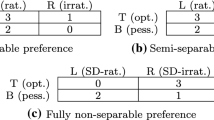Abstract
This paper studies a situation wherein a set of voters choose between two alternatives in the presence of a payoff externality. Specifically, regardless of her intrinsic preference, a voter’s payoff is maximized should she vote for the alternative that garners a majority of the votes cast. Are votes coordinated on a single alternative? Using laboratory experiments, we examine voting patterns in sequential voting and simultaneous voting elections. Across both election types, we also vary the amount of information that an individual voter has regarding the intrinsic preferences of the other voters. Our main findings are as follows. In the “low” information treatment, sequential voting elections facilitate coordinated voting. However, in the “high” information treatment, voting patterns are not dependent on how the election is structured.
Similar content being viewed by others
References
Austen-Smith, D., & Banks, J. (1996). Information aggregation, rationality, and the Condorcet jury theorem. American Political Science Review, 90, 34–45.
Bartels, L. (1985). Expectations and preferences in presidential nomination campaigns. American Political Science Review, 79, 804–815.
Bartels, L. (1988). Presidential Primaries and the Dynamics of Public Choice. Princeton: Princeton University Press.
Battaglini, M. (2005). Sequential voting with abstention. Games and Economic Behavior, 51, 445–463.
Battaglini, M., Morton, R., & Palfrey, T. (2005). Efficiency, equity, and timing in voting mechanisms. Princeton University and New York University, mimeo.
Bikhchandani, S., Hirshleifer, D., & Welch, I. (1992). A theory of fads, fashion, custom, and cultural change as informational cascades. Journal of Political Economy, 100, 992–1026.
Callander, S. (2004). Bandwagons and momentum in sequential voting. Northwestern University, mimeo.
Coleman, S. (2004). The effects of social conformity on collective voting behavior. Political Analysis, 12, 76–96.
Dekel, E., & Piccione, M. (2000). Sequential voting procedures in symmetric binary elections. Journal of Political Economy, 108, 34–55.
Eckel, C., & Holt, C. (1989). Strategic voting in agenda-controlled committee experiments. American Economic Review, 79, 763–773.
Epstein, L., & Knight, J. (1998). The Choices Justices Make. Washington: Congressional Quarterly Press.
Feddersen, T., & Pesendorfer, W. (1997). Voting behavior and information aggregation in elections with private information. Econometrica, 65, 1029–1058.
Feddersen, T., & Pesendorfer, W. (1998). Convicting the innocent: the inferiority of unanimous jury verdicts. American Political Science Review, 92, 23–35.
Hall, M. (1990). Opinion assignment procedures and conference practices in state supreme courts. Judicature, 73, 209–214.
Krutz, G., & Patterson, S. (2001). Hitching a Ride: Omnibus Legislating in the US Congress (Parliaments and Legislatures). Columbus: Ohio State University Press.
Morton, R., & Williams, K. (1999). Informational asymmetries and simultaneous versus sequential voting. American Political Science Review, 93, 51–67.
Morton, R., & Williams, K. (2001). Learning by Voting: Sequential Choice in Presidential Primaries and other Elections. Ann Arbor: University of Michigan Press.
Oleszek, W. (1984). Congressional Procedures and the Policy Process. Washington: Congressional Quarterly Press.
Rosenne, S. (1995). The World Court: What It is and How It Works. London: Martinus Nijhoff.
Wilson, R., & Herzberg, R. (1988). Results on sophisticated voting in an experimental setting. The Journal of Politics, 50, 471–486.
Wooldridge, J. (2002). Econometric Analysis of Cross Section and Panel Data. Cambridge: MIT Press.
Author information
Authors and Affiliations
Corresponding author
Electronic Supplementary Material
Rights and permissions
About this article
Cite this article
Dasgupta, S., Randazzo, K.A., Sheehan, R.S. et al. Coordinated voting in sequential and simultaneous elections: some experimental evidence. Exper Econ 11, 315–335 (2008). https://doi.org/10.1007/s10683-007-9167-z
Received:
Revised:
Accepted:
Published:
Issue Date:
DOI: https://doi.org/10.1007/s10683-007-9167-z




